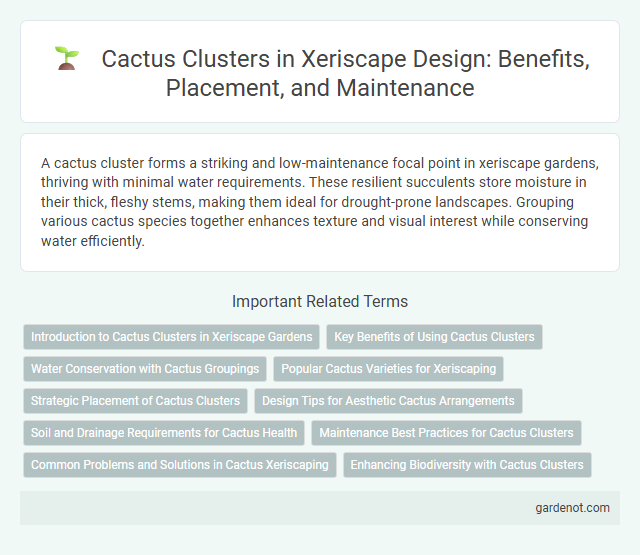A cactus cluster forms a striking and low-maintenance focal point in xeriscape gardens, thriving with minimal water requirements. These resilient succulents store moisture in their thick, fleshy stems, making them ideal for drought-prone landscapes. Grouping various cactus species together enhances texture and visual interest while conserving water efficiently.
Introduction to Cactus Clusters in Xeriscape Gardens
Cactus clusters, essential in xeriscape gardens, offer drought-tolerant and visually striking plant groupings that conserve water while enhancing arid landscape aesthetics. These succulent plants store water in their thick, fleshy tissues, making them highly efficient for xeriscaping and sustainable gardening in dry climates. Incorporating cactus clusters reduces irrigation needs and supports native wildlife, promoting ecological balance in xeriscape designs.
Key Benefits of Using Cactus Clusters
Cactus clusters provide exceptional drought resistance, making them ideal for xeriscape gardens with minimal water consumption. Their dense, spiny formations reduce soil erosion and create natural barriers, enhancing landscape durability. These clusters also support local wildlife by offering shelter and food, promoting biodiversity in arid environments.
Water Conservation with Cactus Groupings
Cactus cluster groupings significantly enhance water conservation by minimizing soil moisture evaporation through dense planting. These succulent arrangements optimize water use efficiency by allowing shared root systems to access limited water resources more effectively. Xeriscape landscapes employing cactus clusters reduce irrigation needs by up to 50%, supporting sustainable drought-resistant gardening.
Popular Cactus Varieties for Xeriscaping
Popular cactus varieties for xeriscaping include the vibrant Barrel Cactus (Ferocactus) known for its spherical shape and bright red spines, the tall and iconic Saguaro (Carnegiea gigantea) which provides vertical interest and wildlife habitat, and the low-growing Prickly Pear (Opuntia) that offers colorful blooms and edible pads. These cacti thrive in arid environments, require minimal water, and enhance landscape aesthetics with diverse textures and forms. Xeriscape designs benefit from integrating these drought-tolerant species to conserve water while maintaining visual appeal.
Strategic Placement of Cactus Clusters
Strategic placement of cactus clusters enhances water conservation by reducing irrigation needs in xeriscape landscapes. Positioning these clusters in sun-exposed, well-drained areas maximizes their drought tolerance and growth potential. Grouping cacti with similar water requirements also promotes efficient moisture retention and minimizes maintenance.
Design Tips for Aesthetic Cactus Arrangements
Create a dynamic cactus cluster by varying heights, shapes, and colors to enhance visual interest and texture in xeriscape gardens. Use well-draining soil and arrange taller cacti at the back with shorter varieties clustered in front to achieve a balanced, layered look. Incorporate decorative rocks and mulch to complement the natural desert aesthetic while aiding water retention and weed control.
Soil and Drainage Requirements for Cactus Health
Cactus clusters thrive in well-draining soil composed of sandy or gritty textures that prevent water retention and root rot, essential for their health. Optimal drainage is achieved with soil mixes containing perlite, pumice, or coarse sand, facilitating rapid water runoff and aeration. Proper drainage also reduces fungal risks, ensuring robust cactus growth in xeriscape gardens.
Maintenance Best Practices for Cactus Clusters
Regularly inspect cactus clusters for signs of pests and diseases to prevent infestations and ensure healthy growth. Water infrequently but deeply, allowing soil to dry completely between watering sessions, which conserves water while supporting the plant's drought tolerance. Remove damaged or dead stems with clean, sharp tools to promote air circulation and reduce the risk of rot.
Common Problems and Solutions in Cactus Xeriscaping
Common problems in cactus xeriscaping include overwatering, poor drainage, and pest infestations such as mealybugs and spider mites. Solutions involve implementing well-draining soil mixtures, establishing precise irrigation schedules to prevent root rot, and applying insecticidal soaps or introducing natural predators to control pests. Proper site selection with adequate sunlight and airflow also reduces disease risk and promotes healthy cactus clusters.
Enhancing Biodiversity with Cactus Clusters
Cactus clusters play a crucial role in xeriscape gardens by providing essential habitats and food sources for pollinators such as bees, butterflies, and hummingbirds, thereby enhancing local biodiversity. Their dense, spiny structures offer shelter and nesting sites for small wildlife, promoting ecosystem balance in arid environments. Incorporating diverse cactus species in clusters supports soil health and water conservation, making xeriscape landscapes both resilient and ecologically beneficial.
Cactus cluster Infographic

 gardenot.com
gardenot.com